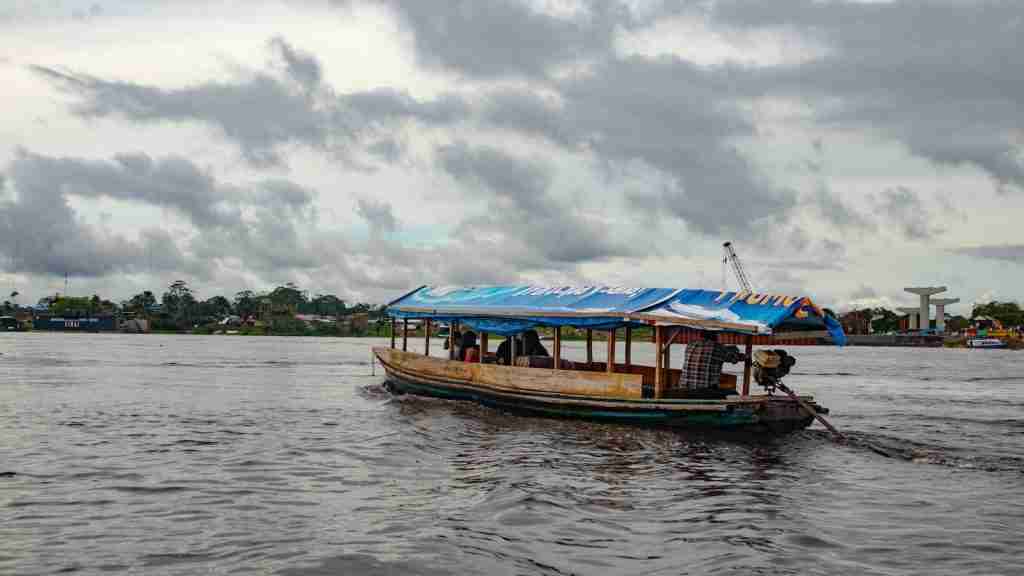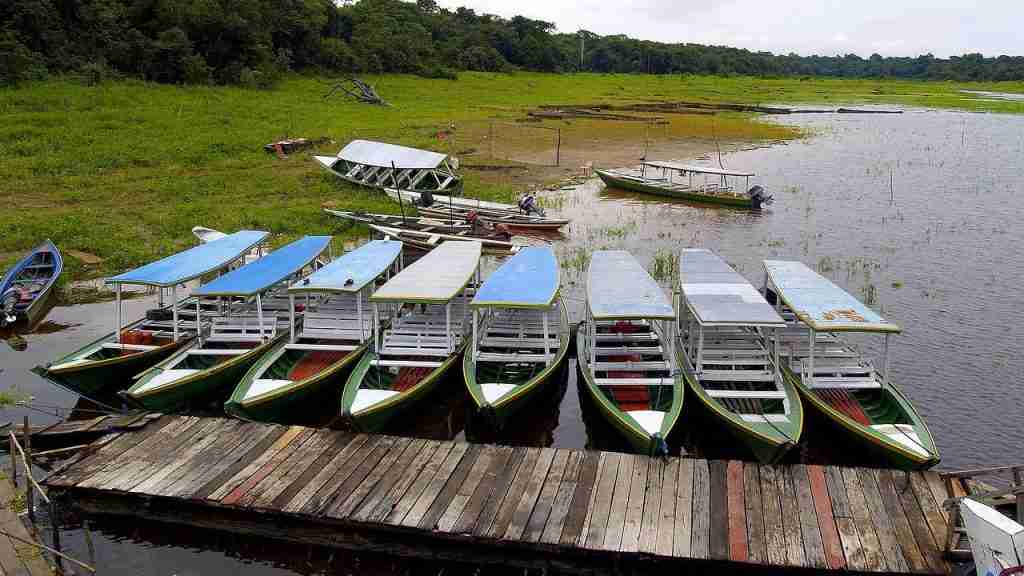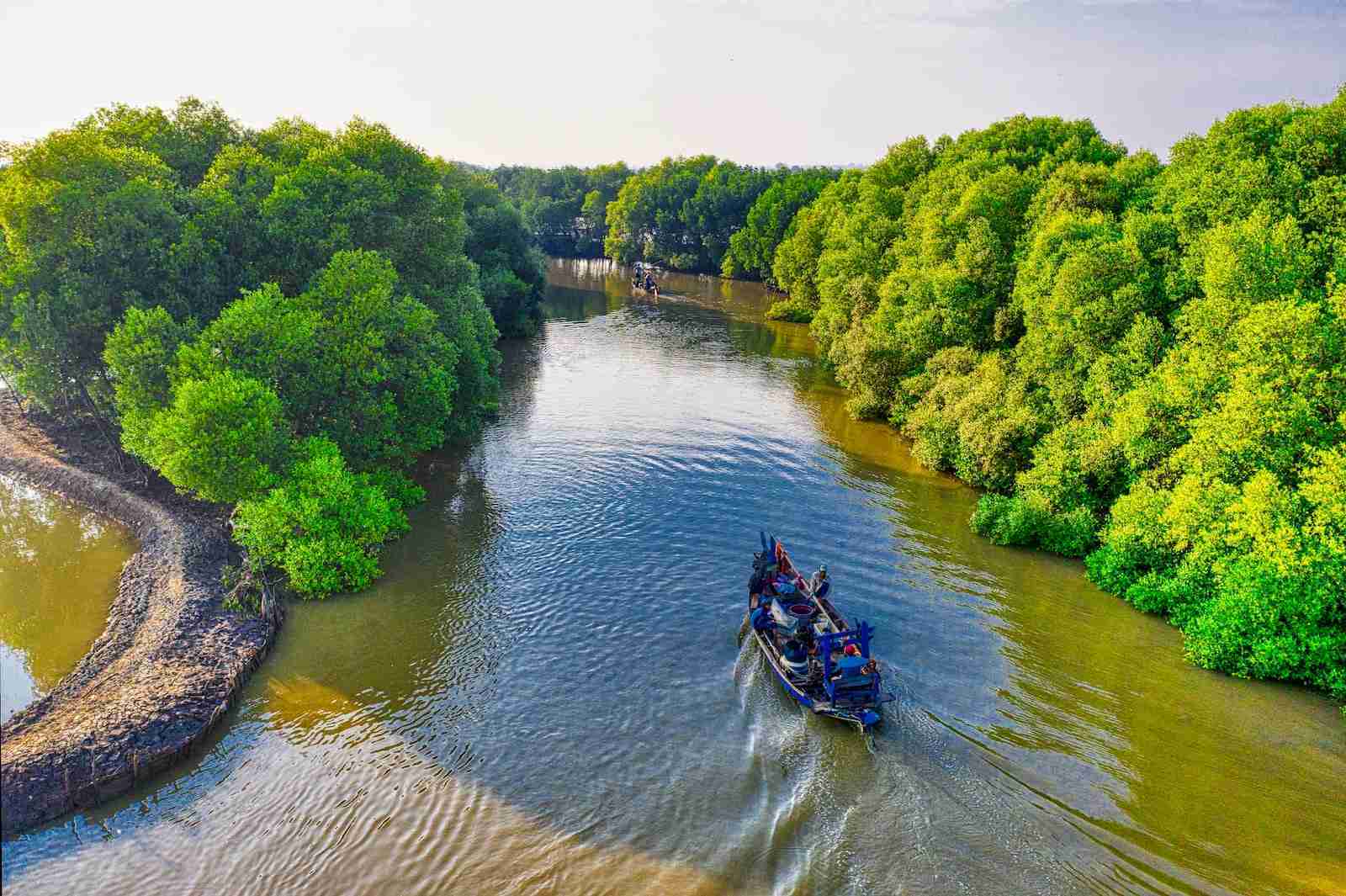22 Facts About The Amazon River (Let’s Dive In)
1. The Amazon River is home to the Pink River Dolphin.
The Amazon River is home to many unique wildlife species, the most distinct being the pink river dolphin. This gorgeous marine mammal is the largest species of aquatic life in South America and is among an exclusive few: only four species of dolphins can live in freshwater rivers and lakes worldwide.
This majestic creature stands out from saltwater dolphins with its beautiful magenta hue – a vastly different color from its oceanic relatives, who predominantly feature bluish-grey coloring.
But special hues aside, its size alludes to an important part of its identity: these creatures can grow up to 8 feet long and weigh as much as 550 pounds. That impressive bulk makes it one of the most noticeable sights across South American waters.
2. Up to 4,000 species of fish live in the Amazon River.
The length and immense volume of the Amazon River and its tributaries make it an ideal environment for many fish species – up to 4,000, in fact.
These species are varied in color and subject matter; some are recognizable, yet many were unknown to us until recently. Of those hundreds of species diving and swimming through the world’s largest annual water system, only a fraction is contemplated by researchers.
3. The Amazon Rainforest is Home to around 30 million people.
Spread across nine countries, the Amazon Rainforest is home to an astounding 30 million people. Among this large population, roughly 2.6 million are native or Indigenous inhabitants.
These remarkable individuals possess a complex knowledge of the region’s rich flora and fauna and maintain many ancestral customs that have been passed down for centuries. Like the Ganges, the Amazon River is a lifeline for numerous communities along its banks.
The Amazon provides many goods and services humans use worldwide that directly contribute to our planet’s biodiversity and evolution cycle.
4. The Amazon River Basin covers over 6.7 million sq km (2.6 million sq miles).

The Amazon River Basin is an impressive geographic structure. Spanning over 6.7 million square kilometers, it surpasses every other watershed on the planet: a staggering 2.6 million square miles of potent natural splendor.
It doesn’t just hold the title of biggest: it’s also home to a vast array of extraordinary flora and fauna, with approximately one-tenth of all species known to humankind living exclusively within the resident habitat of Amazonian air and textiles.
5. The Amazon River is the longest river in South America.
The Amazon River is a sight to behold. Winding its way through South America, it is the longest river in the region, with an impressive 6,992 km (4,345 miles) of meandering length.
It is majestic in both scale and beauty, a stunning vista that cannot be missed when traveling this part of the world. Boasting unparalleled biodiversity, the wonders of its tributary can be felt throughout South America.
6. It is estimated that 20% of all freshwater entering the ocean comes from the Amazon River.
Each day, 20% of the fresh water on earth travels from the vast Amazon River to the oceans. An incredible figure, this 20% equates to a staggering 460 billion gallons of water daily.
This inflow from the world’s largest tropical rainforest contributes to ocean health and prosperity, maintaining seawater balance, providing vital nutrients to millions of species worldwide, and regulating Earth’s climate.
7. The Amazon River contributes one-fifth of the world’s ocean water, with tributaries extending over 7,000 km.
The Amazon River is a vast, immense body of water. It transports an astounding one-fifth of all the water in the world’s oceans, traversing across four countries until it meets the Atlantic Ocean.
The endless tributaries of this remarkable river extend a whopping 7,000 kilometers (4,350 miles). Its size and scope captivate onlookers and scientists alike; many are amazed at its grandeur and monumental prowess.
8. Vicente Yanez Pinzon, a Spanish conquistador, was the first European to discover the Amazon in 1500.

of the Amazon River.
In 1500, a Spanish explorer, Vicente Yanez Pinzon, was the first from Europe to find the Amazon River. He was far out at sea when he found he was sailing in freshwater, not salt water. This made him curious, so he sailed closer to the land.
There, he found where the Amazon River starts. This was a big deal because it was the first time someone from Europe saw this huge and important river.
9. The Amazon Rainforest is estimated to contain 390 billion individual trees.
The Amazon rainforest is a mind-boggling ecosystem. Here, an astounding 390 billion individual trees form the core structure. This makes it the largest tropical rainforest and one of the most biodiverse environments on our planet.
Every day, this gigantic ecosystem critically supports millions of plants and animals seeking shelter in its depths. It reveals that flying with its many colorful birds can make for a majestic view.
The Amazon stands out from anything else like it, covering roughly 2,300,000 hectares in parts of South America, such as Brazil and Peru.
10. The Amazon River is the Largest River by Volume in the World.
The Amazon River is known for its might and volume – it stands as the Largest River by Volume in the World! A marvel of beauty and power, it carries more water than any other river on Earth.
This 600,000-kilometer-long river winds through 9 countries: Brazil, Bolivia, Colombia, Ecuador, Guyana, Peru, Suriname, and Venezuela – some of which are totally dependent on this mighty river’s waters for sustenance and transportation.
11. The Amazon River is so broad that boats must cover up to 15 km to reach the other side.
The Amazon River is nothing short of massive. Boats navigating its waters have to travel up to 9 miles to reach the opposite bank in some areas — that’s a whopping 15 kilometers.
This incredible and expansive river is an incredibly powerful force even at its narrowest pores. To put matters into perspective, 15 kilometers is as far as one would typically travel from a major metropolis and still remain within the same country.
12. Amazon River estimated that 1/5th of all freshwater fish species inhabit the Amazon River.
These highly diverse fish species have made the Amazon their own unique ecosystem for centuries. The stunning variety that can be found around these waters attracts naturalists from across the globe to conduct research every year who keep discovering remarkable new populations previously unheard of.
There is so much satisfaction in unraveling the mysteries that unravel in living these majestic rivers, creating a treasurable moment for those in awe of this incredible spectrum of life.
13. Some 200 Different Languages are spoken by Indigenous Groups living in and around the Amazon region.
Over two hundred distinct and unusual languages can be found among the various native peoples inhabiting the Amazon region. From isolated tribes with their own unique language to little dialects that barely resemble those of neighboring villages, these languages exemplify cultural exchange and development.
However, many of these languages still remain largely arbitrary and undocumented by current science —simultaneously magical and enigmatic in their purpose and origin.
14. The Amazon River is home to several unique species.
The Amazon River is teeming with unique creatures. Electric eels use shock organs for hunting and defense, earning a fearsome reputation. Piranhas, known for their sharp teeth, aggressively attack prey.
Anacondas impressed me by swallowing animals whole and showing strength in fights. The river also hosts caimans, smaller relatives of alligators, yet still formidable in the jungle waters. These species highlight the Amazon’s diverse and captivating wildlife.
15. During the wet season, the Amazon River can rise by as much as 30 meters (98 feet).
The wet season brings an annual occurrence to the Amazon rainforest; the Amazon River will swell to astonishing proportions. Incredibly, it can rise by as much as 30 meters – that’s nearly 98 feet! When this influx of water reaches its peak capacity, extreme floods can form and extend inward for almost 25 miles.
That’s no small event – approximately 40 km of riverside and land is affected in such a way.
16. The Amazon River is Home to some of the Most Diverse Ecosystems on the planet.

An ecosystem with Unique Habitats.
The Amazon River is an incredibly versatile environment. Home to some of the world’s most spectacular and diverse habitats, it encompasses wetlands, flooded forests, savannas, and grassy fields alike.
Utilizing this entire range of ecosystems creates a fascinating mix of life – new species and biodiversity born of such biological diversity far surpassing what exists in other river systems nearby.
17. The Amazon Basin is estimated to harbor around 10% of all known species on Earth.
The Amazon Basin is home to roughly 10% of all known species on Earth. This breaks down to a staggering 2 million unique species across the area.
This number is truly remarkable, as it provides insight into just how rich and biodiverse this region is. In fact, its exuberant levels of life could mean some yet unknown species remain in obscurity.
18. It’s believed that the world’s largest snake can be found in the Amazon River.
The Amazon is home to some of the most impressive creatures on Earth. Notably, the anaconda stands out among them all with its record-breaking size.
It’s believed that the largest snakes, anacondas, have been measured at up to 10 meters in length- equivalent to 33 feet. With such immense size and power, the anaconda is surely one of the top predators in this rich, vibrant ecosystem.
19. The Amazon’s powerful flow reverses the direction of certain tributaries.
The Amazon River is truly an awe-inspiring force of nature. Its impressive power has been known to be so enchanting that its tremendous intensity can physically shove the waters in its tributaries upstream.
This means that this great body of water, both literally and figuratively, has reversed certain waters’ directions against their normal flow.
20. The Amazon River source can be traced to two major streams: the Ucayali and Marañón rivers in Peru.

Ucayali and Marañón rivers in Peru.
The Amazon River has its source in Peru, deep in the Andes. The two primary contributing elements to its originating headwaters are the Ucayali River and the Marañón River.
These two rivers form at the meeting point of Vilcabamba’s Chinchipe Valley and Río Marañón’s Valley in Peru’s mountainous region.
This marks the start of an extensive water system that traverses a lengthy stretch of South America before joining with Brazil’s Tocatins River to assemble its mightiest of flows as it makes bends toward–and into–the Riviera Atlântica.
21. The Amazon River is the second longest river in the world.
With a length of 6,833 kilometers, the Amazon River is an immense landscape spanning across continents. It is the second longest river in the globe after the Nile in Africa, measuring a whopping 6,853 kilometers.
This long, winding, meandering waterway has captivated many for centuries with its dense collection of plants and animals found only in tropical environments.
22. During its course through Brazil, Bolivia, and Peru, it flows through more than half of the world’s remaining rainforest.
The Amazon, the world’s largest river by volume of water, journeyed through three South American countries: Brazil, Bolivia, and Peru. This path spans over half of the world’s rainforest flora and fauna habitats.
This provides both a unique insight and an ecological opportunity for local cultures, environmental activism, and education about conservation efforts worldwide.
It can be studied and promoted to enhance our understanding and appreciation of this magnificent ecosystem.
FAQs
The Amazon River is approximately 4,000 miles (6,400 kilometers) long.
The Amazon River holds approximately 209,000 cubic meters of water per second, making it the largest river in the world by discharge volume.
The water in the Amazon River is not drinkable, as it is murky and filled with dangerous wildlife, such as piranhas and alligators.
No, the Amazon River is not a safe place to swim. The water is murky and filled with dangerous wildlife like piranhas and alligators.
The depth of the Amazon River varies widely, with some areas as shallow as 6 feet (1.8 meters) and others as deep as 300 feet (91 meters).
The Amazon River has over 1,100 tributaries, with some of the largest being the Madeira, Purus, and Negro Rivers.







